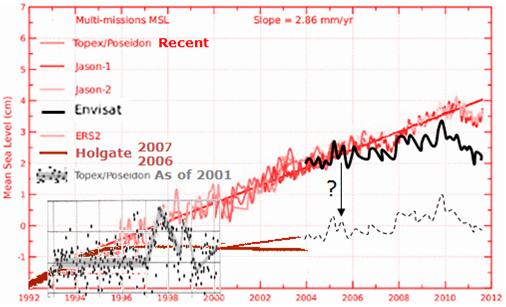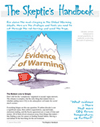|
|
Skeptics, and particularly Nils-Axel Mörner have been saying that sea level rise, as recorded by tide gauges has been much slower than widely advertised. They’ve also pointed out how the rates of sea-level rise have either stayed the same or slowed down. There’s been no sign of the acceleration needed for the wildly speculative hypothesis that your SUV, and China’s coal plants are warming the ocean.
This week a new Nature paper (Hay et al) shows the skeptics were right — but did that view make it to any news broadcast?
Watch the sea-level scare mutate
Even in The Australian the spin from the propaganda machine gets a running, and the previous slow rise is used to pump the scare that the modern “acceleration” is even scarier. What the Australian (and selected sea level “experts”) don’t mention is that the tide-gauges don’t show any acceleration, and nor did the raw recordings from satellites. The 3mm rising sea claims apparently come from satellites that were calibrated to one subsiding tide gauge in Hong Kong.
It’s cherry picking par excellence. We might finally accept tide gauges up to 1990, but after that the tide gauges don’t count — bring in the “adjusted” […]
In The Australian Bob Carter compares the long term tide gauge record in Sydney with projections, and exposes the exorbitant cost of insurance for alarmist sea level forecasts. The good news is that it appears councils are waking up, and “peak-sea-level-panic” is behind us.
Sea-level alarmism has passed high tide and is at last declining. With luck, empirical sanity will soon prevail over modelling.
After years of research it turns out that talking about “global” sea level rise is nearly meaningless to real people who live in one place. The ocean rise varies locally from beach to beach from as little as 5cm per century to as much as 16cm per century. The variations are mostly due to different rates of land subsiding or rising.
More importantly, the rate of rise was either the same or was even faster before World War II when CO2 levels were “safe”.
Figure 5: Comparison of decadal rates of change over historical record. Analysis based on relative 20-y moving average water level time series. | Watson 2011
Fort Denison in Sydney has one of the longest running continuous records, starting in 1886, and finally local councils are realizing that they need […]
Is the latest sea-level rise unusual? Kurt Lambeck said it was, based on his version of the Holocene seas, calculated with modeled crustal movements (to try to guess the rises and falls of the beaches where the sea levels were changing). Obedient science reporters broadcast his message to the world without asking a single hard question. But when the error bars are 2 meters wide and the dating estimates range over hundreds of years, I thought it beyond silly to think we could estimate 100-year average sea level rises in the time of Moses. Nils-Axel Mörner agrees, and shows data below from 50 years of research which demonstrates that sea levels are always oscillating, and that in Europe, the US, the Indian Ocean past changes are larger than the current ones. Nils has published nearly 600 papers on observations of sea-levels around the world. He calls the Lambeck paper an “insult” to geologists and sea-level researchers. — Jo
————————————————————————————————————–
An insult to geology and sea level research
by Nils-Axel Mörner
Paleogeophysics & Geodynamics, Stockholm, Sweden, (morner AT pog.nu)
In the 60s, there was a vigorous debate […]
Kurt Lambeck at ANU scored a Climate Bingo moment in the modern media last week with declarations that the 20cm rise in sea levels last century was “unprecedented” in the last 6,000 years! But sea level is fiendishly difficult to measure thanks to rising and falling bits of land. Present day scientists argue over sea level changes in the last 10 years, yet Lambeck seems to have figured out the sea levels in 4000BC. Tricky, what.
When Nils Axel-Morner tried to figure out which modern spot in Denmark is tectonically stable he looked at 60 years of detailed data, from 40 beaches around Denmark. Lambeck has a model that kinda does all that and more. It works out the mass of the icesheets circa Tutankhamen and calculates the mantle conditions. He sorts out the geoidal bulge with assumptions about mantle viscosity to look at tectonic displacement. Hmm. Could be some uncertainty there?
This is Fig 1 from Lambeck et al 2014. Note the scales. Really. Figure how large the 15-20cm rise of the last century would look on the y axis here which doesn’t just cover 150cm, it covers 150 meters. Who would be brave enough to declare that sea […]
Two papers on ocean heat released together today. The first says the missing heat is not in the deep ocean abyss below 2000m. The second finds the missing heat in missing data in the Southern Hemisphere instead. Toss out one excuse, move to another.
The first paper by Llovel and Willis et al, looked at the total sea-level rise as measured by adjusted satellites*, then removed the part of that rise due to expanding warming oceans above 2,000 m and the part due to ice melting off glaciers and ice-sheets.** The upshot is that the bottom half of the ocean is apparently not warming — there was nothing much left for the deep oceans to do. This result comes from Argo buoy data which went into full operation in 2005. (Before Argo the uncertainties in ocean temperature measurements massively outweigh the expected temperature changes, so the “data” is pretty useless.)
Figure 2 | Global mean steric sea-level change contributions from different layers of the ocean. 0–2,000m (red), 0–700m (green), 700–2,000m (blue). The dashed black curve shows an estimate for the remainder of the ocean below 2,000m computed by removing the 0–2,000m estimate from the GRACE-corrected observed mean sea-level time […]
Here’s a novel approach. Beenstock et al wondered if tide gauges were placed in any old spot around the world or were biased toward area where sea-level did more rising. They compared the location of tide gauges in the year 2000 to sea level rises and falls as measured by satellite altimetry. It turns out the placement seems to be independent (meaning anywhere). This is pretty important because the infernally tough thing about measuring sea levels is whether the land is subsiding or rising at the same time, and how to correct for that. If tide gauges are spread evenly (or quasi-randomly), it means we could average the lot instead of trying to correct and reconstruct each one individually. So that’s what they did – average (they did not reconstruct).
The consensus estimate is that sea-levels are rising by 2mm a year (and 3mm lately, with adjusted satellite data). Beenstock et al used 1,000 tide gauges and found global sea level rise was more like 1mm a year (very similar to the rise Nils Axel Morner found on that stable spot in Denmark). The conclusion is that sea level is rising slowly at 1mm a year, and that it hasn’t […]
Nils‐Axel Mörner has a new paper out (his 589th). For 60 years he has been tracking the coastlines close to him, and carefully isolated the exact part which appears to be the most stable. From that he shows that the real sea-level rise in Northern Europe is less than 1 millimeter a year since 1890. This is less that the 1.6mm trend in 182 NOAA tide gauges, and far below the estimates of the IPCC reports.
There is also no sign of acceleration in sea-levels for the last 50 years. (How much should Europeans spend to stop a 1mm annual rise that was already going in 1890 and has not changed much since then?) If anything, Nils work shows how difficult it is to measure true sea-level rise on land that shifts.
In this graph below, he compares the rise of most tide gauges with the Kattegatt region, and the IPCC results. This is only one result from one place, but it is based on thousands of readings from sites all around Kattegatt. His painstaking attention to extreme detail and empirical data stands in stark contrast to the IPCC where the trend depends heavily on adjustments. (Those adjustments appear to […]
Australia is one of the most stable land masses on the planet, and has more gauges than anywhere else in the southern hemisphere, so it’s very useful for sea-level measurements. It also had a couple of rare continuous long records “… the two longest sea-level records in the southern hemisphere, Sydney Fort Denison from 1886 and Fremantle from 1897″ .
A new paper by White et al, concludes that Australian sea level rises are similar to global measurements (so not a bad proxy for the world), and that during times when CO2 levels were much lower — like before World War II, sea levels were rising at the same speed (or possibly faster) than they are today.
A generalized additive model of Australia’s two longest records (Fremantle and Sydney) reveals the presence of both linear and non-linear long-term sea-level trends, with both records showing larger rates of rise between 1920 and 1950, relatively stable mean sea levels between 1960 and 1990 and an increased rate of rise from the early 1990s.
Does a “larger rate of rise” mean larger than today, or larger than average — I think, given the error margins, that we could only be sure it […]
Dr David Kear
Climate Depot reports on a New Zealand geoscientist who has worked at the highest levels and has just released a detailed statement about why the threat of rising sea-levels has been blown out of all proportions, and “An ‘innocent gas, CO2, has been demonized and criminalized’”.
“The widespread obsession with Global-Warming-Climate-Change, in opposition to all factual evidence, is quite incredible.”
Kear laments the ‘Astronomical Cost of Major Measures to Combat a Non-Existent Threat’.
His scientific caliber: “Dr David Kear has a background in geology and engineering, becoming the Director General of the DSIR (Department of Scientific and Industrial Research) in 1980. He is a Fellow and Past Vice-President of the Royal Society of New Zealand, and Past President of the New Zealand Geological Society [which promises to catalogue his work here]. Dr Kear has over 100 publications on New Zealand and Pacific geology, vulcanology and mineral resources.” Apparently a foraminifera shell was named after him in 1962.
He has been in this for a very long time.
h/t to Ian for the link to Steven Goddard.
Six Grave Scientific Errors and the history of an absurd idea
Kear […]
Filed under the Semi-Satirical Press.
The Universe is surely conspiring against ecologicist scientists*. Their task is to convince the world that things are dire, and yet just as humans pump out more carbon dioxide pollution than ever before, many natural markers start behaving as if CO2 was having barely any effect at all. It’s all potentially so misleading.
A new paper by Cazenave et al 2014 digs deep to uncover the reasons for yet another unfortunate un-catastrophic trend change.
First, global surface temperatures stopped rising in the late 1990’s. Now, it’s become irrefutable that, for the last ten years, the rate of sea-level rise slowed by thirty percent. Seas were rising at 3.5mm a year up til 2003, then the rate fell to 2.2mm per year for the next eight years. This is exactly what ninety-eight percent of expert Global Climate Models did not predict. The slowing sea level rise is extra problematic because it forms the backbone of the excuse for the long pause in surface warming that wasn’t supposed to happen either. The fact that it coincided with the global pause in surface temperatures was no comfort at all. The missing heat, after all, must be […]
The CSIRO decided to leave out some information about the state of our climate in their State of the Climate Report CSIRO.
CSIRO published these “Fast Facts” in bold. I’m publishing the things they didn’t say, but could have, in points in between.
UPDATE: The CSIRO budget is $1.2 billion a year and the BOM’s is $300 m. Why is it left to unfunded volunteers to provide the full story?
Fast Facts from the CSIRO and BOM “Australia’s climate has warmed by 0.9°C since 1910, and the frequency of extreme weather has changed, with more extreme heat and fewer cool extremes.” The CSIRO-BOM team could have said: Scientifically, extreme weather measures are lousy indicators. They’re noisy and not very meaningful. They are however useful for getting newspaper headlines. It depends on what your aim is… Australia’s had extreme hot days for as long as we’ve been measuring the temperature. Charles Sturt recorded 53C in 1828 which seems fairly extreme. Thomas Mitchell did it too in 1845 and are many others (see the map below, check Trove, ask the BOM — no don’t ask the BOM). The records prior to 1910 seem to have gone down the memory hole, […]
A new paper shows that sea levels rose faster in the ten years from 1993-2003 than they have since. Sea levels are still rising but the rate has slowed since 2004. This does not suggest that the missing energy from the atmosphere has snuck into the ocean, but rather that the oceans and the atmosphere were both warming faster in the 1990’s, then as coal power ramped up in China and billions of tons of CO2 was released, both the atmosphere and the ocean did not gain more energy per year, but less. That message again — something else appears to be the main driver the climate, not CO2.
Their highlights include:
The global mean sea level started decelerated rising since 2004. Deceleration is due to slowdown of ocean thermal expansion during last decade. Recent ENSO events introduce large uncertainty of long-term trend estimation.
This paper discusses and graphs total sea level rise, steric sea level rise and the global mean ocean mass. The Steric Sea Level is the part of the rise due to warming and salinity changes, so it best represents changes in ocean heat content. The total rise also includes water coming or going due to changes […]
Proving that nature can outdo anything humans have done, a new paper shows that sea-levels off Western Australia may have risen as high as 9 m above the current level during the last warm period over a hundred thousand years ago. The authors (O’Leary et al) conclude that seas were 3-4 m higher for most of the last warm period (known as the Eemian) but towards the end of the period a large sudden rise occurred. They suggest that an ice shelf collapsed in Antarctica or Greenland or both, causing a 5m rise (17 feet).
The point of the paper was this double spiked shape of the sea level rise during the last warm interglacial known as the Eemian.
The Age interviewed O’Leary who said “he was confident that the 17-foot jump happened in less than a thousand years – how much less, he cannot be sure.”
Figure 3 j Relative sea-level curve for Western Australia. Ageomorphically defined palaeoMSL datum of C2:5m 120 kyr ago (Fig. 1c) anchors a predicted relative sea-level curve at Red Bluff, which includes a GIA signal based on the test calculation (see Methods) plus the following ESL history: ESL jumps from 0 to 3.4m […]
Willie Soon has some fun with the sea-level debate, going back to William the Conqueror, and landmarks in England.
Are sea-levels “accelerating”? Can the satellites resolve sea-level to 1mm changes a year? Why is the raw data so different?
I think the strongest point is the one Nils Axel Morner has made about the extraordinary adjustments in the raw satellite data, which Willie Soon refers too soon after the 20 minute mark.
Willie is always a rapid fire presenter, getting a good response from the audience…
I’d like to know more about Pevensey Castle (7 mins). It was built in 300AD or so, and at the time was a Roman Fort. The sea surrounded it on three sides, now it is 1.5km from the sea. William the Conqueror landed there (or close to it) in 1066. Apparently the water was so high, they used to toss prisoners over the wall and the tide would take their bodies away. Now it is high and dry. Apparently the marshes around the castle have also been actively reclaimed as the land was so valuable. Obviously there are several factors at work. [Google images show how far the sea is now.]
[…]
“Gale Force” cherries coming your way…
Two weeks ago, it was all over the news. The ocean near Perth (where I live) was rising at the terrifying rate of 9-10mm per year since 1993, which was, shockingly, “three times the global average”. (Since Perth is flatter than flat, at this rate, in a few years everything bar Kings Park and a few sky-scrapers would be washed away). The myth started because a government department that knows a lot about our roads, trains, and buses wrote a dot point in a Fact Sheet. That was the State of Australian Cities report, and a pollie (Albanese) raved. Then the West Australian newspaper headlined it, and it all got out of hand.
In contrast, Chris Gillham got the raw data (something you’d think The Department of Infrastructure might have thought of), and shows below why its nonsense on stilts. The rate is not measured from when records began, but from 1993, which (surely it’s just a coincidence) also happens to be the lowest level in local tide gauges since 1941. (See that second last “dip” near the right-end in the graph below?) If they’d started the “rate” from the year 1999, the headlines […]
We’ve all heard the dire prophesies: Rising seas will reshape the world’s coastlines, a one meter rise will inundate 7000 sq mi of dry land, and cost over $100 billion in the United States alone. Worse, we thought things were bad before, but now it’s even rising faster than we predicted. (“We” being the unvalidated computer simulations, and “rising”, as it turns out, being one interpretation of some highly adjusted, carefully selected data, all possibly “corrected” by one outlying tide gauge in Hong Kong).
Nils-Axel Mörner is here to point out that the raw satellite data shows barely any rise, and furthermore, the observations from places all over, like the Maldives, Suriname, Tuvalu, India, Bangladesh, Venice, and Germany show not much either. It’s close enough to zero to call it “nothing”. Oh.
But that’s only spots from The Atlantic, The Pacific and The Indian… there are other oceans. 😉
As we graphed before with Frank Lansner, most of the current “rise” is due to man-made adjustments, not man-made emissions. According to Mörner, it’s not that the sea levels are rising less than expected, it’s more like they aren’t rising much at all, and haven’t been for years . — Jo
[…]
It’s hard to measure sea levels, because land often moves up and down too (which is known as “isostatic“). But Australia is stable tectonically, so the Australian sea-level record is more useful than most. It preserves the holocene era and the rises and falls, and correspond more with glacio-eustatic (ice equivalent) sea-level changes, rather than changes in land masses.
During the coldest days of the last ice age (known as a glacial maximum) 20,000 years ago, the oceans were 125m lower than today. They peaked at around 1 -2 meters higher than present between 9000 and 5000 years ago, and have been trending down ever since. Our current rate of 30cm/century (if that continues) hardly seems unprecedented or highly unusual. And 10% of that is apparently due to an isostatic “adjustment”. Worse, if you look at the raw data, the rate is closer to zero. Hmm. Lucky we have all those adjustments eh?
If Australian sea levels keep falling at this rate, we might really need to save That Reef.
Clearly there are many details yet to be worked out about sea-levels.
That phenomenal rise out of the ice age:
…
WA and NSW coastlines are considered the […]
Frank Lansner’s first graph surprised me. It’s well known and often quoted that sea levels have been rising by 2-3mm a year every year for the last 20 years. But it’s not well known that the original raw satellite data doesn’t show that at all. What astonished me was the sea levels first recorded by the Topex Poseidon satellite array showed virtually no rise at all from 1993-2001. Surely not, I thought. I asked sea-level expert Nils Axel-Morner, and he confirmed: “Yes, it is as bad as that.” Now, given that Envisat (the European satellite) showed no rise from 2003-2011 (until it was adjusted) that means we have almost 20 years of raw satellite data showing very little rise. We thought satellites would finally give us a definitive answer on sea levels. Instead, like the tide gauges, and every other tool available to mankind, apparently satellites systematically underestimate the rising trends. And despite the speed of light being quite quick and all, it can take years for the data to finally arrive. Sometimes 4 or 5 (or 10 years) after the measurement was made scientists “discover” that it was wrong. Now of course, any one of these adjustments could be for very legitimate reasons and give us results closer to the truth. But the adjustments always bring data closer to the modeled trend. It’s decidedly non-random. Either there is a God who thinks teasing climate scientists is spiffy, or else there is something fishy going on, and some investigative journalists need to ask some investigative questions. Is that sea-level rise due to global warming or is it due to global adjustments? — Jo
————————————————————————————————————-
Edited by Jo Nova
Sea levels – the raw data is always adjusted upwards
[caption id="" align="aligncenter" width="506" caption="The raw data on sea levels is repeatedly adjusted "up""] [/caption] […] [/caption] […]
The answer seems so bleeding obvious. Local governments are ruling on what people can do with their own land if it happens to be near seas recorded as rising at a frightening 1mm per year. Home owners are losing options and home value, not because of the rising water, but because of rising nonsense.
Let’s assume that IPCC projections might, incredibly, actually come to pass — why don’t the councils just get all residents to sign a clause before they buy or renovate. We the residents and potential residents, won’t mind signing that we have seen The Official Council Climate Warning:
—————————————————–
“The IPCC estimates the oceans may rise by (insert wild prediction here).
The council cannot be held responsible for the weather, and will not hold back the ocean.
Buy or renovate at your own risk!”
—————————————————–
Who has more incentive to assess the threats to a house (your house): a/ you, the homeowner who just hocked yourself to the grave and wants to live in it, hand it to your kids, or on-sell it for a decent quid; or b/ the local councillors who will never set […]
The Daily Telegraph exposed the NSW state government protecting the world from some dangerous scientific analysis of sea-levels. The officials pulled papers and posters within days of when they were due to be released, late in September 2011. Doug Lord examined 120 years of tidal data from Sydney Harbour, and found a 1 mm year on year rise which didn’t fit with the 900 mm rise projected by the Wizards of Climate Change at the Department. He finds the official figures exaggerate ten fold.
Ken Stewart has taken the dangerous data from 19 sites around Australia and finds it averaged 1.4 mm/year over the last 100 years. He finds about an 8-fold exaggeration. This is another sordid tale in the Science-perverted-for-PR category.
Sea Level Change in Australia: What’s Likely?
The mean sea-level rise recorded at 19 stations around Australia (warning, data is limited in the first half of the series). The trend is a steady rise. The last 20 years is not unusual.
Seas have been rising in a reasonably continuous trend around the world since 1800. The last two decades are not unusual.
9.4 out of 10 based on 87 ratings […]
|
JoNova A science presenter, writer, speaker & former TV host; author of The Skeptic's Handbook (over 200,000 copies distributed & available in 15 languages).

Jo appreciates your support to help her keep doing what she does. This blog is funded by donations. Thanks!


 Follow Jo's Tweets
Follow Jo's Tweets To report "lost" comments or defamatory and offensive remarks, email the moderators at: support.jonova AT proton.me
Statistics
The nerds have the numbers on precious metals investments on the ASX
|













Australian sea level rises exaggerated by 8 fold (or maybe ten)
The Daily Telegraph exposed the NSW state government protecting the world from some dangerous scientific analysis of sea-levels. The officials pulled papers and posters within days of when they were due to be released, late in September 2011. Doug Lord examined 120 years of tidal data from Sydney Harbour, and found a 1 mm year on year rise which didn’t fit with the 900 mm rise projected by the Wizards of Climate Change at the Department. He finds the official figures exaggerate ten fold.
Ken Stewart has taken the dangerous data from 19 sites around Australia and finds it averaged 1.4 mm/year over the last 100 years. He finds about an 8-fold exaggeration. This is another sordid tale in the Science-perverted-for-PR category.
Sea Level Change in Australia: What’s Likely?
The mean sea-level rise recorded at 19 stations around Australia (warning, data is limited in the first half of the series). The trend is a steady rise. The last 20 years is not unusual.
Seas have been rising in a reasonably continuous trend around the world since 1800. The last two decades are not unusual.
9.4 out of 10 based on 87 ratings […]